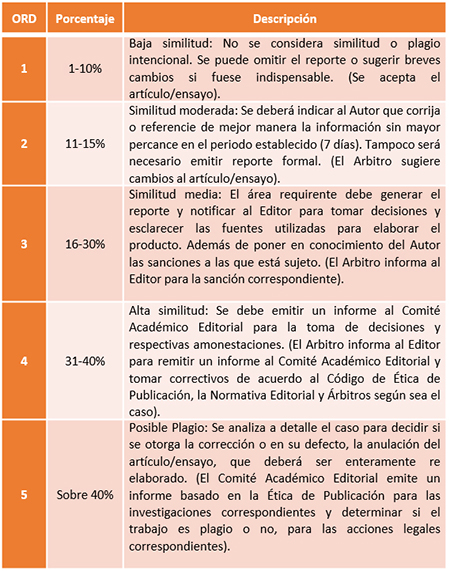Antiplagiarism and Analysis Criteria
Anti-Plagiarism Tool
The Revista Iberoamericana de Docencia, Investigación y Desarrollo, in order to guarantee the originality of its articles, recognizes documents that are not unpublished, indicating their source.
The Revista Iberoamericana de Docencia, Investigación y Desarrollo checks the veracity of the proposals sent to it by the authors, through the antiplagiarism program Plagirims, which is a system that contrasts the content of these manuscripts with information published on the Internet, printed sources and its own archive, composed of articles and research of all academic levels. The RIDID only supports texts that contain up to 10% similarity.
Evaluation criteria
Plagiarism means the use of ideas, graphics, phrases and paragraphs of published works without the authorship of them being explicitly recognized to differentiate the original work from the cited work. Plagiarism is committed when, intentionally or unintendedly, other people's works are presented as their own, which is a total lack of the academic integrity on the author’s behalf, which is not admitted by RIDID. In this sense, with the intention of ensuring the veracity and reliability of the manuscripts, the RIDID Scientific Council, in conjunction with the Scientific Committee of the Central American University of Higher Studies, is governed by the following criteria:
Analysis criterion
To ensure the authenticity and correct source of the document information, acceptable similarity parameters and certain percentage guidelines have been established.
It is emphasized that, after manually reviewing the delivered document, it is corroborated that quotations and texts are correctly referenced, or whether it is truly a situation of plagiarism of information; this trial must be determined by the analysts or publishers in charge of the manuscript.
Criteria for valuation of the percentage of content similarity

Source: http://www.indteca.com/ojs/index.php/Revista_Scientific/antiplagio
Whenever high similarity percentages are detected, these results are notified so that the editors in charge ensure the optimal and actual level of the manuscript's qualification.



